Pat Narduzzi, Quarters Coverage And The Evidently Extant MSU Defense: A Rope Of Sand
[ED: BUMP.]
WTFL;DR: Narduzzi coaches an aggressive take on the now en vogue Quarters defense that's still formidable even if State isn't quite what it was last year.
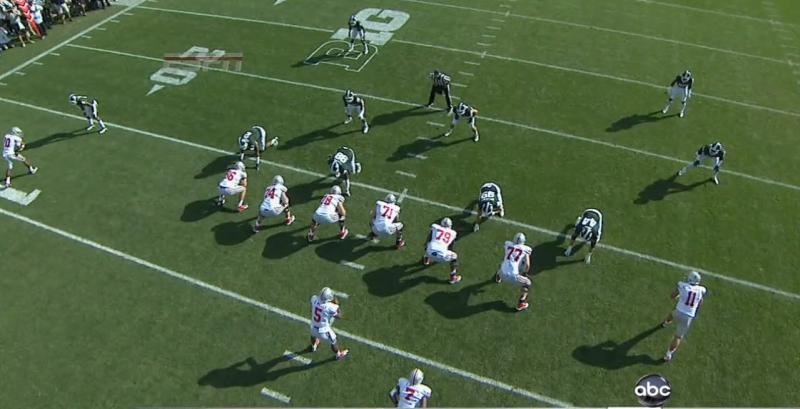
We got to the point where, this is the reason that we do this, when everybody started going spread we couldn’t play 3 deep zone. This started with the Cleveland Browns, I was the defensive coordinator in the early 90s and Pittsburgh would run 'Seattle' on us , four streaks. Then they would run two streaks and two out routes, what I call ‘pole’ route from 2x2. So we got to where could NOT play 3-deep zone because we rerouted the seams and played zone, and what I call “Country Cover 3” [drop to your spot reroute the seams, break on the ball]. Well , when Marino is throwing it, that old break on the ball shit don’t work.So because we could not defend this, we could not play 3 deep, so when you can’t play zone, what do you do next? You play Man [cover 1], but if their mens are better than your mens, you can’t play cover 1 .We got to where we couldn’t run cover 1 - So now we can’t play an 8 man front. The 1994 Browns went 13-5 , we lost to Steelers 3 times, lost 5 games total [twice in the regular season, once in the playoffs]. We gave up the 5th fewest points in the history of the NFL, and lost to Steelers because we could not play 8-man fronts to stop the run because they would wear us out throwing it
For example, if the offense splits out two wide receivers to the same side of the field, and both run straight up the field on deep routes, the safety plays man on the inside guy and the cornerback plays man on the outside guy. If, however, the inside receiver were to run immediately to the flat -- say, on a bubble screen -- while the outside receiver ran upfield, the corner and the safety would actually double team the deep man, defending him from both the inside and the outside. This type of read-and-react is great against the spread's multiplicity, as it can allow some very short completions but lead to lots of interceptions and few downfield passing windows.


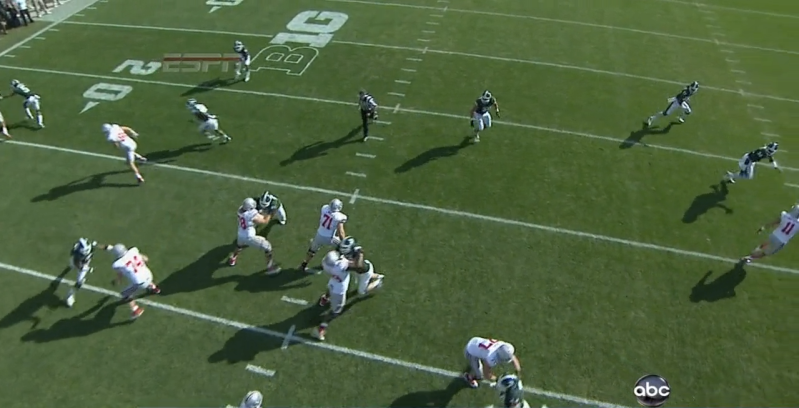

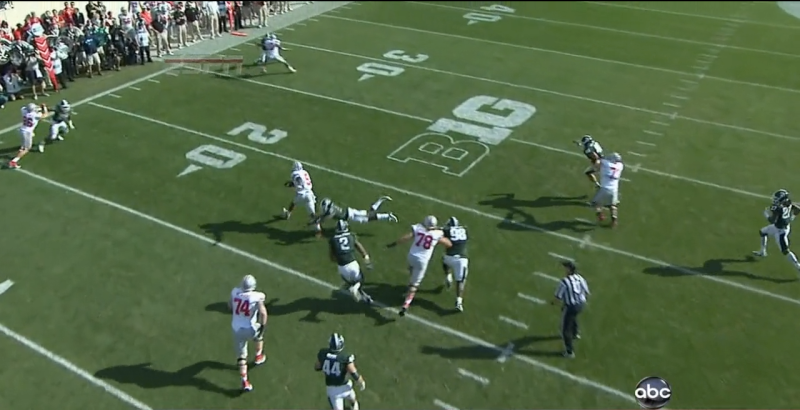

What did Johnson change at Miami? Some of this you already know. To stop the wishbone option on the edge, you need fast OLBs and Ends. Johnson decided to recruit Safety-types, 6'-6'2 190-210lb, which are fairly easy to find, and put them at OLB. If you bulk them up without losing their speed, you have more speed on the field, but it doesnt matter how tall they are, they just have to be fast and tackle well. He took the guys who played LB in HS and moved them to DE, again you put more speed on the field......In the 4-3, in general (meaning either Under or Over), you put the Ends down off the shoulder of the OT and angle them to the RB so they can make the Block-Down-Step-Down rule work easier...The BDSD rule says that when the OL across from you blocks down (towards the center), you must follow him and step down (towards the center) the LOS. Once you think about how the option works, with linemen constantly veering inside to option off the End, you see how this worked against the wishbone teams of the time. This stops the Dive of the option, which is the basis of the system(s) and makes it go. If the Dive went inside or the QB tried to keep, the End would be right in his face.The faster OLBs could just run around the OL who went to the 2nd level.

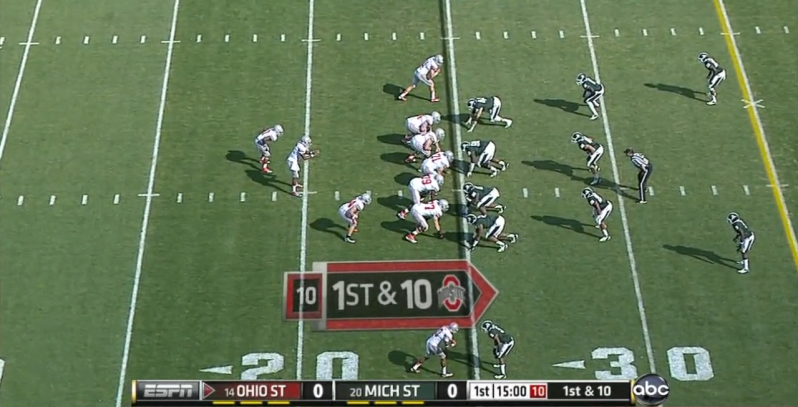
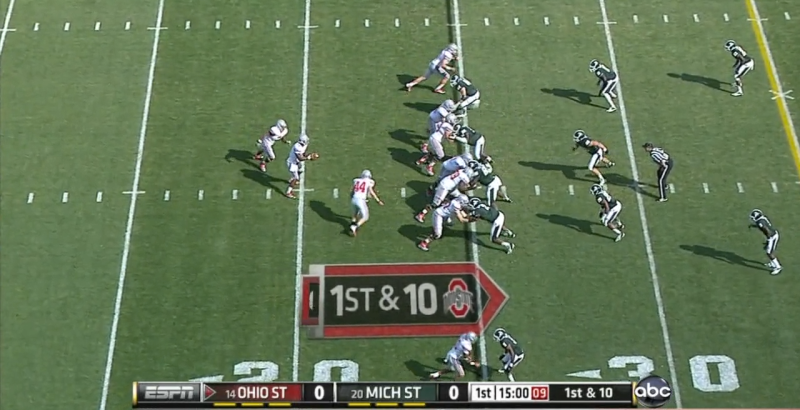
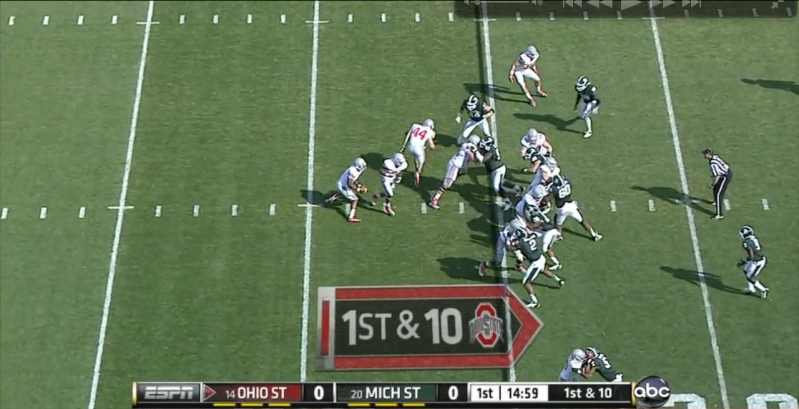
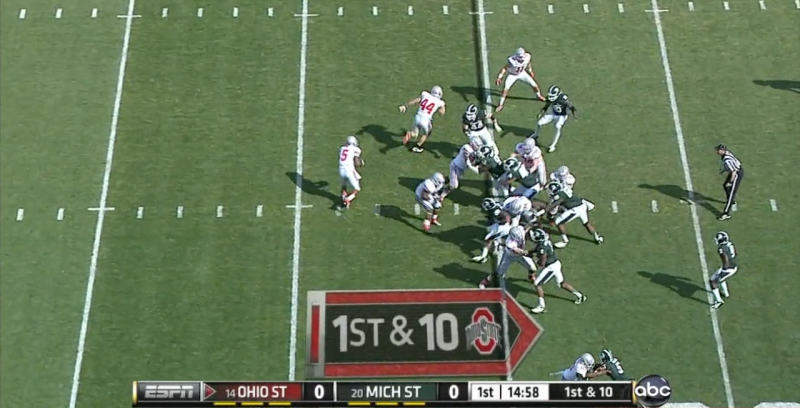
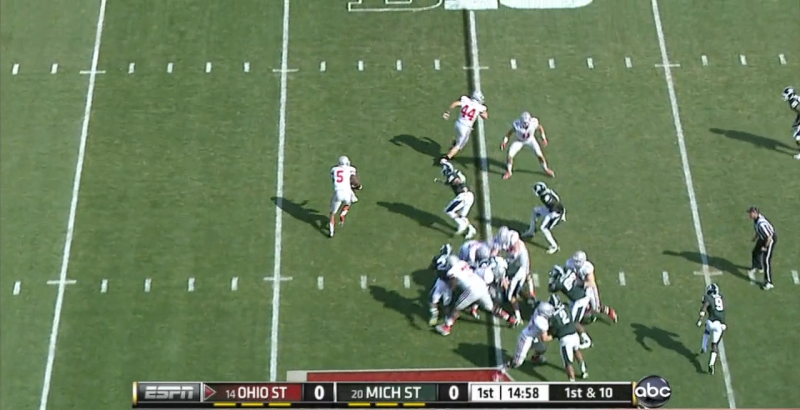
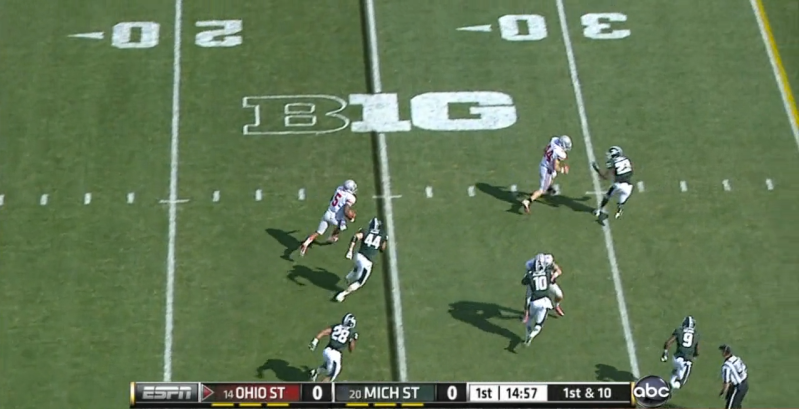
October 18th, 2012 at 6:33 AM ^
I look forward to seeing how this all plays out.
October 18th, 2012 at 8:18 AM ^
October 18th, 2012 at 9:06 AM ^
October 18th, 2012 at 10:22 AM ^
This is something Brian wrote in respect to the gap blitz -
*[I was just reading that Smart Football post he linked about matching short passes with runs, which would have been perfect here. A-gap blitz? Immediate toss to slot/TE. Still need to block up the middle to get the QB some time.]
October 18th, 2012 at 11:48 AM ^
October 18th, 2012 at 12:28 PM ^
Last year the Roundtree slant pass was that play that went for a touchdown. In Borges's frudtration and "all in" texas hold'em mentality, he called that play again on 4th and inches, and had another touchdown if the TE had picked up the CB long enough for Denard to throw a slant.
Everyone was inflamed and grabbing pitchforks, cause like Denard rarely has a negative run, and like they just needed inches. But inches only get you a first down, and I don't know how many times Hoke has stated that he hates it when any offensive possesion fails to result in a TD. Maybe like every presser?
Both Mattison and Borges have had their moments when they've called a play that ended up beyond the team's ability to execute. But I like that gambler style, and despite Manball seeming to be like Lloydball, it is not. Lloyd played for position, and holding on to your position.
Hoke is about movement and progress toward the goal. Just like Patton. Patton's strategy was to always move, never hold onto a position. It's not Lloyd ball and it's not Bo Ball.
October 18th, 2012 at 1:17 PM ^
October 18th, 2012 at 11:46 AM ^
October 18th, 2012 at 8:37 PM ^
October 18th, 2012 at 9:33 AM ^
Excellent diary and very informative.
At least within the conference, the #1 and #2 teams in total defense (MSU is 7th nationally, and we are 10th) will be going at it on Saturday, so it will be interesting to see what Borges does here indeed. One thing that I find interesting is that you can see in the numbers where State's own tendencies (covered wonderfully in this diary) get used to burn them on runs - they have only given up an average of 91 yards rushing after 7 games, but their three losses (ND, OHIO, Iowa) are instances where they gave up more rushing yards than their average.
October 18th, 2012 at 9:38 AM ^
Great read! As RakeFight said, this kind of article is what keeps the readers coming back. Thanks for putting it together.
October 18th, 2012 at 10:04 AM ^
This is a great post, and you hope/suspect that Borges has figured out how to attack the scheme with play action, screens, or whatever else he has up his sleeve. As much as I like to scream at the TV, I suspect that Borges has something figured out that's within our player's abilities.
But I'm mostly just commenting to say thank you. This is really good content, and an upvote seems insufficient thanks.
October 18th, 2012 at 10:08 AM ^
Amazing post. I think you are right on a number of levels; and I think this is a close game that tells us a lot about who we are as a team. If we win, I think our chances of running the table are very good. If we lose, I think we'll probably lose another game as well. We need the confidence of executing our offense against a defense that's designed to stop it.
While all of this scheming is awesome to read about and very important, I think the most important factor in this game is a simple concept: DENARD CANNOT TURN THE BALL OVER. If we play our game and don't get too cute, adding just a few wrinkles and constraint plays, I think we win a close game. If we get too cute and try to make big changes and rely on Denard's arm too much, I think we'll find ourselves passing to players wearing green and losing a close game.
I wish we were at the point where our talent could control this game. We're not there yet. But 2014 isn't far away...
October 18th, 2012 at 10:09 AM ^
Really great content, very well written. Thank you for taking the time to put this together.
October 18th, 2012 at 10:39 AM ^
Narduzzi is a great d coordinator. I see him as head coach somewhere big in 2013 (Auburn, Colorado, UVA...)
October 18th, 2012 at 10:58 AM ^
Good stuff, thanks for posting.
I have to believe you are a coach. No casual fan puts that much time into learning this much stuff as a hobby.
Your theory about Borges is spot on, imo. It's the same criticism I had for Mike Martz. He was convinced that he was the smartest offensive coordinator on the planet and that he could outscheme any defense he ever faced. If his team failed, it wasn't because his scheme was bad, but because his players just weren't good enough and smart enough to execute the plan. Very frustrating.
It's actually what makes Narduzzi and Mike Tressel good coaches. They simplify it with some very basic rules, alignments, and responsibilities. "Do this when you see this. Do that when you see that. Other than that, go as fast as you can." I believe Mattison is similar in philosophy but a little more complicated by design.
October 18th, 2012 at 11:35 AM ^
October 18th, 2012 at 11:55 AM ^
What blogs do you read for this kind of in-depth analysis?
October 18th, 2012 at 3:31 PM ^
October 18th, 2012 at 3:07 PM ^
Great post, and this is going to be a great college football game. Old school, power vs. power, strength vs. Strength. I like the analysis of taking advantage of their overpursuit and agressive to action, and hitting edges and PA.
Very interest comparsion with Martz and Borges. I have quietly opined this to some friends, and they are not buying it so far, but I see some parallels. Having said that, next couple years will be interesting to see how Borges transitions us. I see really genius and unstoppabilitiy in what he wants to do, and I hope we continue with the multiple offensive looks, with some run spread elements.
October 18th, 2012 at 11:20 AM ^
Is this front-paged yet? This is gold, Jerry!
October 18th, 2012 at 12:55 PM ^
Nice article, but the title is rather misleading. Quarters is a pass coverage scheme adapted to support the run D; most of the article focused on the front 7's reads. The safeties' keys were insightful but it was almost a segue.
Reading it, though, I understand Borges' desire to revert to a power-based game. Defending the spread has forced even B1G teams to utilize smaller, faster players at outside LB to protect the edge. Personnel-wise, a DC frozen in 1985 and thawed in 2012 would wonder why today's defenses are using dime packages on running downs. There's a reason why Wisconsin has been running over the B1G these past few years despite not being all that good. A TE against a glorified FS playing OLB should be a mismatch you can exploit in both the run and the pass.
MGoBlog has stated that Fitz is in a funk and sure he's missed some pretty huge running lanes, but I wonder if the adjustments Borges made to the read option game heavily favored Denard by accident. The delayed handoff, for one, basically turns the read option into a game of chicken. It was scouted early on that Denard didn't read the DE so much as the edge, so the DE just got outside the tackle and the free hitter converged on Fitz. Borges' answer (finally!) was to delay the handoff so Denard could actually read the DE, but the rest of the lines don't exactly take a break. Fitz has less time to read the blocking (instead of crashing down the DE can basically "cheat" a couple yards while Denard makes up his mind); this could explain why he's been making some inexplicably weird decisions lately. OTOH, the DE not committing to Denard as early as possible allows the offense to spot the free hitter. By the time the D knows Denard's gonna keep, the free hitter is accounted for and at least one OL is blocking the second level. The result? Fitz has to fight for yards while Denard gets 10ypc even if the defense is keyed on stopping Denard. Kinda goes against what Borges said he wanted, but I think he saw what he hath wrought and decided, "Eh, I'll take it." As a bonus, Denard is now running out of bounds once he gets past the sticks.
October 18th, 2012 at 2:14 PM ^
October 18th, 2012 at 1:18 PM ^
I like the cut of your jib.
October 18th, 2012 at 1:30 PM ^
This is really well-written and informative. Great read. Thanks for taking the time to put this together, I really appreciate it.
October 18th, 2012 at 2:00 PM ^
unfortunately, it makes me very nervous for the game. We basically see that MSU is designed to stop the run and by having there corners play man and thier LBs and Safeties read and react they are easily able to get a lot of hats to the ball.
The scheme is incredibiliy simple when geared towards running teams, which UM is. DE crash, everyone else clean up.
This makes me less confident in the run game. Braxton is a juke his way out of a phone book runner while Denard is a hard step and accelerate N/S runner. Given the numbers they will have at the LOS this does not bode well for UM as Denard won't be able to get N/S freely.
Really hope Borges has come up with some safe pass play counters to this scheme. Running will be a tough go in the game. We will have many 3rd and longs IMO. UM will need to pund away (Rawls) and make them pay with timely, well executed passes that counter the MSU scheme. I feel like good TE's could do a lot of damage.
October 18th, 2012 at 2:56 PM ^
This really helps give the reader a great idea what to look for this weekend. I'll have my eyes peeled.
Also, if Lewan wants to return any favors and break Tom Gholston's arm or remove his head, that would be fine with me . . . .
October 18th, 2012 at 3:25 PM ^
This is the type of analysis you rarely see on the networks. I think this game rides on how Borges attacks the State defense.
October 18th, 2012 at 3:54 PM ^
Can you just coach the offense on Saturday?
October 20th, 2012 at 9:37 AM ^
Wow, that was the best thing I read on the Internet in weeks.
December 22nd, 2014 at 9:20 AM ^

Comments